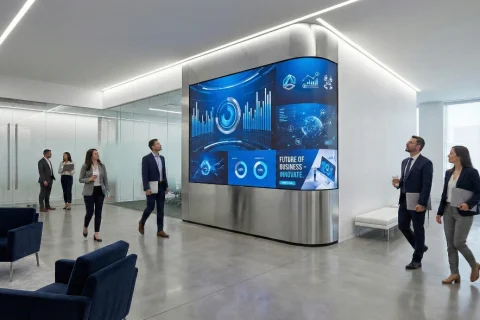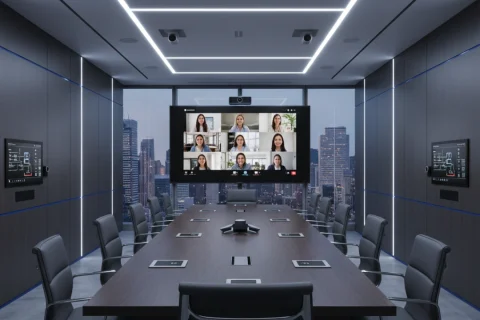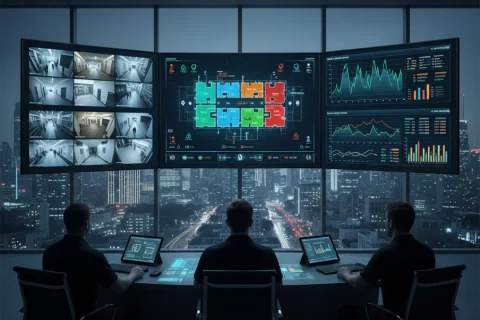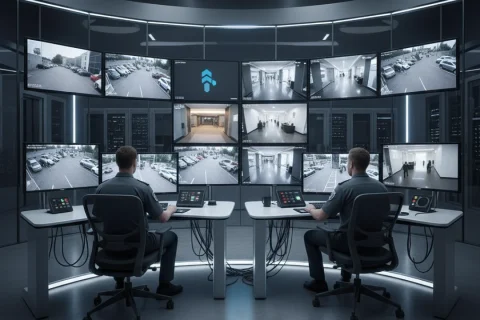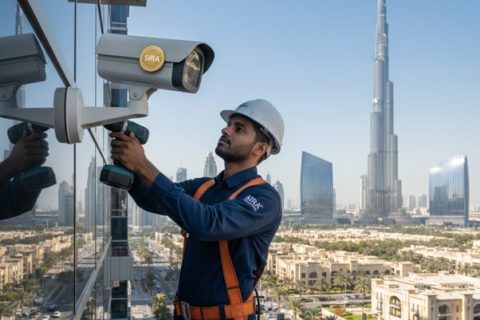Introduction
An ELV security system transforms how modern facilities protect assets, personnel, and operations through integrated low-voltage technology. As businesses face increasingly sophisticated security threats, traditional standalone systems no longer provide adequate protection. Today’s smart infrastructure demands comprehensive security solutions that seamlessly integrate multiple technologies from access control and video surveillance to intrusion detection and emergency communication systems. This integrated approach not only enhances security effectiveness but also streamlines management, reduces operational costs, and provides actionable insights through data analytics. In this guide, you’ll discover how ELV security systems work, their core components, implementation strategies, and why they’re essential for future-ready facilities across industries.
Key Takeaways
- ELV security systems integrate multiple low-voltage technologies including CCTV, access control, intrusion detection, and fire alarms into a unified platform for comprehensive protection
- Modern ELV systems reduce installation costs by 30-40% compared to conventional high-voltage alternatives while offering superior scalability and easier maintenance
- Integration capabilities enable real-time monitoring, automated responses to security events, and centralized management across multiple locations
- Proper system design and professional implementation ensure regulatory compliance, optimal performance, and long-term reliability for critical infrastructure
Understanding ELV Security Systems and Their Core Components
An ELV security system operates on extra-low voltage (typically under 50V AC or 120V DC), making it inherently safer and more cost-effective than traditional high-voltage installations. These systems form the backbone of modern security infrastructure by integrating various subsystems into a cohesive network. The primary components include video surveillance (CCTV), access control systems, intrusion detection sensors, fire alarm integration, and emergency communication networks. What sets ELV security systems apart is their ability to communicate and coordinate responses across all these components simultaneously.
For example, when an intrusion sensor triggers, the ELV system can automatically lock specific doors through the access control system, direct cameras to focus on the affected area, alert security personnel through the communication network, and log all events for forensic analysis. This level of integration eliminates the vulnerabilities created by isolated security systems and significantly improves response times during critical incidents. Modern ELV security systems also leverage IP-based technology, enabling remote monitoring, cloud storage, and integration with business intelligence platforms for predictive security analytics.
Video Surveillance and CCTV Integration
Video surveillance serves as the visual foundation of any comprehensive ELV security system. Modern IP-based cameras offer 4K resolution, low-light capabilities, and intelligent video analytics that can detect unusual behavior patterns, recognize faces, count occupants, and identify potential security threats before they escalate. Unlike traditional analog systems, IP cameras integrate seamlessly with other ELV system components, enabling automated responses based on visual triggers.
Advanced video management systems (VMS) within ELV frameworks provide centralized control over hundreds or thousands of cameras across multiple locations. These platforms support features like motion-activated recording, edge storage for network resilience, and AI-powered search capabilities that can locate specific individuals or vehicles across massive video archives in seconds. For organizations seeking SIRA-approved security solutions, integrating certified CCTV systems with ELV infrastructure ensures compliance while maximizing protection effectiveness.
Access Control and Identity Management
Access control systems within the ELV security framework regulate who enters specific areas, when they can enter, and under what conditions. Modern biometric readers, RFID cards, mobile credentials, and multi-factor authentication methods provide flexible yet secure entry management. These systems integrate with HR databases to automatically update permissions based on employee status changes, visitor management systems to track temporary access, and emergency systems to facilitate rapid evacuation when needed.
The intelligence of an ELV system shines in access control integration. For instance, if someone attempts to use credentials outside their authorized schedule or in an unusual pattern, the system can trigger additional verification steps, alert security personnel, and activate surveillance cameras to document the event. This proactive approach transforms access control from a simple door lock into an intelligent security layer that adapts to potential threats in real-time.
Intrusion Detection and Alarm Systems
Intrusion detection sensors form the perimeter defense of an ELV security system, using motion detectors, glass-break sensors, door/window contacts, and infrared beams to identify unauthorized entry attempts. When integrated properly, these sensors create invisible security zones that can differentiate between authorized personnel, potential intruders, and environmental factors to minimize false alarms while maintaining high sensitivity to genuine threats.
Modern intrusion systems within smart ELV frameworks employ machine learning algorithms to recognize normal activity patterns and flag anomalies. This intelligent detection significantly reduces the false alarm rates that plague traditional systems, some implementations report up to 90% reduction in false alarms. When combined with video verification, security teams can instantly assess threat legitimacy before dispatching response personnel, saving time and resources while maintaining vigilance.
Strategic Implementation: Planning Your ELV Security System
Implementing an effective ELV security system requires thorough planning that considers current security needs, future scalability, regulatory requirements, and operational workflows. The first critical step involves conducting a comprehensive security risk assessment to identify vulnerabilities, high-value assets, traffic patterns, and potential threat vectors specific to your facility. This assessment should evaluate physical security gaps, existing system limitations, staff security awareness, and compliance requirements.
Based on the assessment findings, develop a detailed system architecture that maps out sensor placement, camera coverage zones, network infrastructure requirements, and integration points with existing systems. Consider factors like lighting conditions, environmental challenges, network bandwidth, power backup requirements, and maintenance accessibility. Engage stakeholders from security, IT, facilities management, and operations to ensure the design addresses all functional requirements while remaining within budget constraints.
Industry statistics reveal that proper planning reduces implementation costs by approximately 25% and decreases post-installation modifications by over 60%. Organizations that invest time in the planning phase also achieve faster commissioning times, fewer operational disruptions during installation, and higher user adoption rates. Working with experienced providers who understand both ELV system integration and industry-specific requirements ensures your security infrastructure delivers optimal protection from day one.
Integration with Building Management Systems
One of the most powerful advantages of modern ELV security systems is their ability to integrate seamlessly with building management systems (BMS), creating a unified smart building platform. This integration enables security systems to leverage HVAC data, lighting controls, elevator management, and energy systems to enhance both security effectiveness and operational efficiency. For example, when the access control system detects the last employee leaving a floor, it can trigger the BMS to adjust lighting and temperature settings, reducing energy waste while maintaining security monitoring.
This convergence also improves emergency response capabilities. During a fire alarm, the integrated system can automatically unlock specific doors for evacuation routes, direct elevators to ground level, activate emergency lighting, disable HVAC to prevent smoke spread, and provide real-time occupancy data to first responders. Such coordination simply isn’t possible with isolated systems and can save critical seconds during emergencies.
Scalability and Future-Proofing Considerations
An effective ELV system must accommodate organizational growth and technological evolution without requiring complete replacement. IP-based architecture provides inherent scalability, adding new cameras, sensors, or access points typically requires only network connections rather than extensive wiring modifications. Cloud-hybrid approaches offer even greater flexibility, allowing organizations to scale storage, processing power, and analytical capabilities on demand.
When planning your system, consider emerging technologies like IoT sensor integration, artificial intelligence for predictive security, 5G connectivity for wireless components, and blockchain for access credential management. Choosing platforms with open APIs and industry-standard protocols ensures you can adopt innovations as they mature without being locked into proprietary ecosystems. Forward-thinking organizations also plan for increased data storage requirements, bandwidth expansion, and cybersecurity measures to protect increasingly connected security infrastructure.
Industry Applications and Use Cases
ELV security systems serve diverse industries, each with unique security requirements and operational constraints. In healthcare facilities, these systems protect patients, staff, and sensitive medical data while maintaining HIPAA compliance. Hospitals integrate access control with patient tracking, infant security tags, pharmaceutical storage monitoring, and emergency lockdown capabilities. The systems must balance security with accessibility, ensuring medical staff can move quickly during emergencies while preventing unauthorized access to restricted areas.
Manufacturing and industrial facilities leverage ELV systems to protect intellectual property, prevent workplace accidents, and secure hazardous materials. Video analytics monitor production lines for safety compliance, access control restricts entry to dangerous equipment areas, and environmental sensors detect chemical leaks or temperature anomalies. Integration with industrial control systems enables coordinated responses that protect both personnel and production assets.
Retail environments use ELV security systems for loss prevention, customer behavior analysis, and staff safety. Advanced video analytics identify shoplifting patterns, access control manages cash handling areas and stockrooms, and integrated panic buttons provide discreet emergency alerts for staff. The same surveillance infrastructure that enhances security also generates valuable business intelligence about customer traffic patterns, dwell times, and space utilization that inform merchandising decisions.
Critical Infrastructure Protection
For critical infrastructure including data centers, utilities, transportation hubs, and government facilities, ELV security systems provide defense-in-depth protection against physical and cyber threats. These high-security implementations typically feature multiple authentication layers, armed response integration, vibration sensors on perimeter fencing, thermal imaging for 24/7 monitoring, and sophisticated analytics that detect reconnaissance activities before actual intrusion attempts.
Many critical facilities implement zone-based security models where the ELV system manages progressive access restrictions from public areas requiring minimal credentials to highly restricted zones requiring biometric authentication, escort procedures, and mantrap entries. The system maintains detailed audit trails of all access attempts, successful entries, and security events to support compliance with regulations like NERC CIP, CFATS, or classified information requirements.
Maintenance, Compliance, and Best Practices
Maintaining optimal performance of your ELV security system requires regular preventive maintenance, firmware updates, functional testing, and staff training. Establish a maintenance schedule that includes monthly visual inspections of all sensors and cameras, quarterly testing of alarm and access control functions, semi-annual backup system verification, and annual comprehensive system audits. Document all maintenance activities to demonstrate regulatory compliance and identify trends that might indicate emerging issues.
Cybersecurity must be integral to ELV security system management. Change default passwords immediately upon installation, implement network segmentation to isolate security systems from general IT networks, enable encryption for all data transmission, establish role-based access controls for system administration, and maintain firmware updates to patch known vulnerabilities. Consider working with experienced IT solution providers who offer comprehensive maintenance contracts covering both physical security components and network security aspects.
Training staff across multiple levels ensures your investment delivers maximum value. Security personnel need training on system operation, event response protocols, and investigative procedures. IT staff require knowledge of network configuration, integration management, and troubleshooting. General employees should understand how to use access credentials properly, recognize security anomalies, and report suspicious activities through established channels.
Regulatory Compliance and Standards
ELV security systems must comply with various local, national, and international standards depending on industry and location. In the UAE, SIRA (Security Industry Regulatory Agency) certification is mandatory for security system installations in Dubai, establishing minimum standards for equipment quality, installation practices, and system design. Other common standards include EN 50131 for intrusion detection, ISO 27001 for information security management, NFPA 72 for fire alarm systems, and ADA requirements for accessibility.
Compliance extends beyond initial installation to ongoing operations. Maintain documentation including as-built drawings, equipment certifications, maintenance records, incident logs, and audit reports. Regular compliance audits identify gaps before they become violations, protecting organizations from fines while ensuring security systems perform as intended during critical events. Partnering with providers experienced in smart building solutions who understand regional requirements streamlines compliance management.
Conclusion
An ELV security system represents a strategic investment in comprehensive protection, operational efficiency, and future-ready infrastructure. By integrating video surveillance, access control, intrusion detection, and emergency communication into a unified platform, these systems deliver security effectiveness that isolated solutions cannot match. The scalability, cost-efficiency, and intelligence of modern ELV systems make them essential for organizations seeking to protect assets, ensure personnel safety, and maintain business continuity in an increasingly complex threat environment.
As security challenges evolve and smart building technologies advance, the role of integrated ELV systems will only grow more critical. Organizations that invest in well-designed, properly maintained ELV security systems today position themselves for safer, more efficient operations tomorrow. Whether you’re protecting a single facility or a global enterprise, the right ELV security infrastructure provides the foundation for comprehensive protection and operational excellence.
Ready to transform your facility with an advanced ELV security system? Contact Vega Digital IT Solutions today to discover how our expertise in ELV integration and smart infrastructure can deliver tailored solutions for your security needs.
Frequently Asked Questions
What is an ELV security system?
An ELV security system is an integrated low-voltage security solution operating under 50V AC that combines CCTV surveillance, access control, intrusion detection, and fire alarms into one unified platform for comprehensive facility protection.
How does an ELV system differ from traditional security systems?
ELV systems operate on low voltage, reducing installation costs and improving safety compared to conventional high-voltage systems. They offer superior integration capabilities, enabling seamless communication between multiple security components for coordinated responses and centralized management.
What are the main components of an ELV security system?
The core components include IP-based CCTV cameras, biometric access control readers, motion detection sensors, intrusion alarms, fire detection systems, and emergency communication networks, all integrated through a centralized management platform for unified security operations.
Why are ELV security systems important for smart buildings?
ELV systems enable smart buildings to integrate security with building management systems, automating energy controls, optimizing operations, and improving emergency response coordination. Learn more about choosing the best ELV system for your facility.
How much does an ELV security system cost to install?
Installation costs vary based on facility size, component selection, and integration complexity, typically ranging from $15,000-$200,000. However, ELV systems reduce expenses by 30-40% compared to traditional systems while offering better scalability and lower maintenance requirements.
Can ELV systems integrate with existing building infrastructure?
Yes, modern ELV systems use IP-based architecture and open protocols to integrate seamlessly with existing HVAC, lighting, elevator systems, and legacy security equipment. This flexibility minimizes disruption during upgrades and protects previous technology investments.
What industries benefit most from ELV security systems?
Healthcare facilities, manufacturing plants, retail stores, data centers, and infrastructure projects benefit significantly. Each industry leverages ELV systems for specialized needs from patient safety and workplace protection to loss prevention and critical asset security.
How often should ELV security systems be maintained?
Regular maintenance should include monthly visual inspections, quarterly functional testing, semi-annual backup verification, and annual comprehensive audits. Partnering with professional IT solution providers ensures optimal system performance, regulatory compliance, and long-term reliability.
Are ELV security systems cybersecurity protected?
Modern ELV systems incorporate multiple cybersecurity layers including network encryption, role-based access controls, regular firmware updates, and network segmentation. Proper configuration and ongoing security monitoring protect against unauthorized access, data breaches, and cyber threats targeting connected infrastructure.
What certifications should ELV security systems have?
Quality ELV systems should meet ISO 27001 for information security, EN 50131 for intrusion detection, and regional standards like SIRA certification in Dubai. These certifications ensure equipment quality, installation standards, and regulatory compliance.

